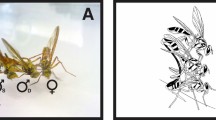Summary
Social behavior of a species in the little-known insect order Zoraptera is described for the first time. Zorotypus gurneyi Choe (Insecta: Zoraptera) is a wing-dimorphic species that lives colonially under the bark of rotting logs in central Panama. Males are larger than females in total body size and fight each other to gain access to females. Highly linear and stable dominance hierarchies exist among males. Higher-ranking males show such agonistic behavior as jerking, chasing, head-butting, hindleg-kicking, and grappling, whereas subordinates often try to avoid contacts. Higher-ranking males, the dominant males in particular, are well recognized by others and relatively free of injuries. Although the dominant males are often the largest, the correlation between body size and dominance rank is not always significant. The mating system of Z. gurneyi is an example of female defense polygyny in which the dominant males obtain the majority of matings (75% on average). Mating success among Z. gurneyi males is much more variable than that of some lekking species.
Similar content being viewed by others
References
Alcock J (1979) The evolution of intraspecific diversity in male reproductive strategies in some bees and wasps. In: Blum MS, Blum NA (eds) Sexual selection and reproductive competition in insects. Academic Press, New York, pp 381–402
Appleby MC (1983) The probability of linearity in hierarchies. Anim Behav 31:600–608
Arnold SJ, Wade MJ (1984) On the measurement of natural and sexual selection: theory. Evolution 38:709–719
Austad SN (1984) A classification of alternative reproductive behaviors and methods for field-testing ESS models. Am Zool 24:309–319
Bateman AJ (1948) Intra-sexual selection in Drosophila. Heredity 2:349–368
Bateson P (1983) Mate choice. Cambridge University Press, Cambridge
Bekoff M (1977) Quantitative studies of three areas of classical ethology: social dominance, behavioral taxonomy, and behavioral variability. In: Hazlett BA (ed) Quantitative methods in the study of animal behavior. Academic Press, New York, pp 1–46
Bradbury JW, Vehrencamp SL, Gibson R (1985) Leks and the unanimity of female choice. In: Greenwood PJ, Harvey PH, Slatkin M (eds) Evolution. Cambridge University Press, Cambridge, pp 301–314
Breed MD, Smith SK, Gall BG (1980) Systems of mate selection in a cockroach species with male dominance hierarchies. Anim Behav 28:130–134
Brown JL (1975) The evolution of behavior. Norton, New York
Chase ID (1974) Models of hierarchy formation in animal societies. Behav Sci 19:374–382
Choe JC (1989) A new species Zorotypus gurneyi from Panama and redescription of Z. barberi Gurney (Zoraptera: Zorotypidae). Ann Entomol Soc Am 82:149–155
Choe JC (1990) The evolutionary biology of Zoraptera (Insecta). PhD dissertation, Harvard University, Cambridge
Choe JC (1992) Zoraptera of Panama with a review of the morphology, systematics, and biology of the order. In: Quintero D, Aiello A (eds) Insects of Panama and Mesoamerica: selected studies. Oxford University Press, Oxford, pp 249–256
Choe JC (1994) Sexual selection and mating system in Zorotypus gurneyi Choe (Insecta: Zoraptera): II. Determinants and dynamics of dominance. Behav Ecol Sociobiol
Clutton-Brock TH, Guinness FE, Albon SD (1982) Red deer: behavior and ecology of two sexes. University of Chicago Press, Chicago
Crespi BJ (1988) Risks and benefits of lethal male fighting in the colonial, polygynous thrips Hoplothrips karnyi (Insecta: Thysanoptera). Behav Ecol Sociobiol 22:293–301
Darwin C (1871) The descent of man and selection in relation to sex. John Murray, London
DeVore I (1965) Male dominance and mating behavior in baboons. In: Beach F (ed) Sex and behavior. Wiley, New York, pp 266–289
Emlen ST, Oring LW (1977) Ecology, sexual selection, and the evolution of mating systems. Science 197:215–223
Howard RD (1978) The evolution of mating strategies in bullfrogs, Rana catesbeiana. Evolution 32:850–872
Jackson WM, Winnegrad RL (1988) Linearity in dominance hierarchies: a second look at the individual attributes model. Anim Behav 36:1237–1240
Landau HG (1951) On dominance relations and the structure of animal societies. I: Effect of inherent characteristics. Bull Math Biophys 13:1–19
LeBoeuf BJ (1974) Male-male competition and reproductive success in elephant seals. Am Zool 14:163–176
OConnor BM (1993) Life-history modifications in astigmatid mites. In: Houck MA (ed) Mites: ecological and evolutionary analyses of life-history patterns. Chapman-Hall, New York, pp 136–159
Payne RB (1984) Sexual selection, lek and arena behavior, and sexual size dimorphism in birds. Ornithol Monogr 33:1–52
Robinson SK (1986) Benefits, costs, and determinants of dominance in polygynous oriole. Anim Behav 34:155–241
Rubenstein DI (1980) On the evolution of alternative mating strategies. In: Staddon JER (ed) Limits to action: the allocation of individual behavior. Academic Press, New York, pp 65–100
Schjelderup-Ebbe T (1922) Beitrage zur Sozialpsychologie des Haushuhns. Z Psychol 88:225–252
Searcy WA, Yasukawa K (1983) Sexual selection and red-winged blackbirds. Am Sci 71:166–174
Strum SC (1982) Agonistic dominance in male baboons: an alternative view. Int J Primatol 3:175–202
Thornhill R, Alcock J (1983) The evolution of insect mating systems. Harvard University Press, Cambridge
Trivers RL (1972) Parental investment and sexual selection. In: Campbell BG (ed) Sexual selection and the descent of man. Aldine, Chicago, pp 136–179
Wade MJ, Arnold SJ (1980) The intensity of sexual selection in relation to male sexual behavior, female choice, and sperm precedence. Anim Behav 28:446–461
Wilson EO (1975) Sociobiology: the new synthesis. Harvard University Press, Cambridge
Author information
Authors and Affiliations
Rights and permissions
About this article
Cite this article
Choel, J.C. Sexual selection and mating system in Zorotypus gurneyi Choe (Insecta : Zoraptera). Behav Ecol Sociobiol 34, 87–93 (1994). https://doi.org/10.1007/BF00164179
Received:
Accepted:
Issue Date:
DOI: https://doi.org/10.1007/BF00164179




